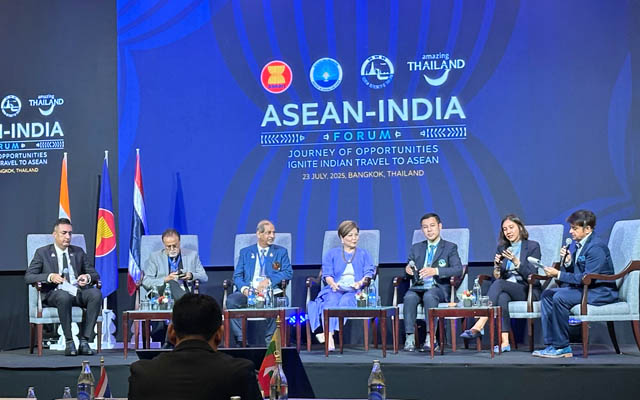At the ASEAN-India Forum, the session titled Emerging Trends in Demand and Travel Experiences that Attract Indian Travellers explored ways for the region to tap India – the world’s fastest-growing outbound travel market.
Last year, ASEAN as a region welcomed six million Indian tourists. Thailand alone drew nearly 2.1 million Indian tourists in 2024 – a record number – making India one of its largest source markets.

“India currently sends nearly 30 million outbound travellers annually; that’s just two per cent of our population. Once airlift improves, ASEAN can expect a surge,” commented Shreyash Shah, commercial director at Destination Hospitality Management.
“Tier II and III cities are where the next wave will come from,” underscored Santosh Kumar, country head, Indian Subcontinent & Indonesia at Booking.com.
He added that destinations should move beyond massive blanket campaigns to consider micro-targeting secondary destinations.
“Regional influencers often outperform Bollywood stars or national celebrities in building trust and engagement,” he advised.
Vathanachai Vathanakul, vice president of the Association of Thai Travel Agents (ATTA), highlighted the group’s 2024 road shows to Hyderabad and Chennai – cities that have historically received less attention.
“During this two to three year period, we’re focusing on South India. North India has already seen many road shows, but South India has been left behind,” he said.
Vathanakul notes this is shifting, driven by direct flights from both Thai Airways and budget carriers such as Nok Air. ATTA road shows in September 2025 will target Cochin and Andhra Pradesh, with Cochin already ranked among Thailand’s top 10 Indian source cities.
“India is performing,” said Nikhil Sharma, managing director and COO, South Asia at Radisson Hotel Group, highlighting a rise in premium hotel stays, group travel and multi-generational family travel.
“Guests are willing to pay more for larger rooms and upgrades. They travel with extended families and want rooms in the same corridor, vegetarian food options, and high-speed Wi-Fi. Personalised service is essential – they’re used to being pampered at home and expect that abroad,” he underscored.
Even small details like seeing Hindi channels or having Hindi-speaking staff can foster loyalty. He also pointed to the distinct mindsets, customs, and preferences of North, South, and West Indians.
“Indians are diverse – that’s why true personalisation matters – whether it’s during check-in, dining, or respecting religious practices,” he observed.
Shivya Nath, travel writer and founder of The Shooting Star, pointed to a mindset shift among younger Indian travellers. She said: “They’re done with traditional marketing. They want immersive, conscious travel that tells stories – not just photo ops. They’re seeking value – not in terms of price, but in meaning.”
She encouraged destinations to move away from performative culture and instead offer authentic community engagement and emotional storytelling.
“Reintroduce known places with fresh angles. Offer bespoke itineraries. Give them something real,” she commented.
Sharma added: “Social media is leading the way for this market – get the value for money, family-friendliness and food choices right and you win.”
Chuan Thakar, president of the Indian Association of Thailand, called on ASEAN governments to think bigger, especially with sports tourism: “If you want to bring Indians to ASEAN, bring cricket. It’s a religion in India. Just one Indian Premier League event could bring 10,000 visitors and a billion baht in value. Why should Dubai host it all?”
He added that Dusit Thani Hua Hin is one of the few Thai hotels with a cricket ground – a missed opportunity in his view.
Panellists agreed that simplifying travel, particularly through visa relaxations, has been highly effective in attracting Indian travellers.
Sharma also noted a strong preference for last-minute deals and bundled experiences: “They’re looking for curated packages that agents are well-positioned to deliver, along with shorter trip durations and priority access.”
Meanwhile, improved regional airlift remains a critical enabler.
“Airlines are the bridge,” said Krid Pattanasan, head of government relations at Thai AirAsia.
He noted that as of November 2024, only 36,759 weekly seats were allocated between major Indian metro cities and Thailand.
Sharma also suggested that India should actively look to attract more travellers from ASEAN markets.
“India sent six million travellers last year to ASEAN countries, but we only received 700,000. Cultural exchange and greater understanding will happen once India starts to receive more ASEAN travellers,” he concluded.











